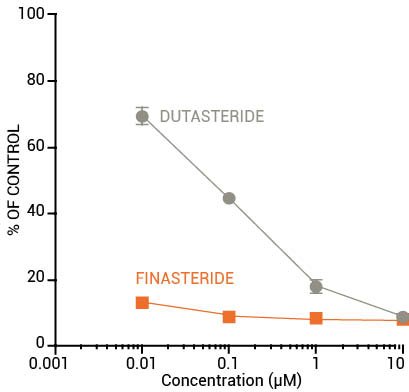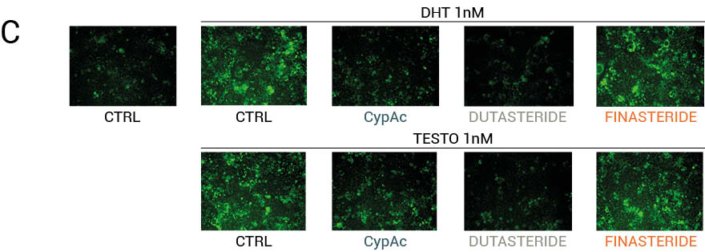1 – Effects of Dutasteride, Finasteride and CypAc on [14C]-Testo metabolism (A) and DHT production (B); 24h assay.
2 – (A) Effects of Dutasteride, Finasteride and CypAc on RASD1 expression after 4 h stimulation with DHT or Testo – (B) Effects of drugs (1µM) on AR translocation (1h assay with DHT) – Effects of drugs (1µM) on lipid accumulation (7days assay, with DHT or Testo).
CONCLUSIONS
In this model,
– Dutasteride is a strong inhibitor of DHT production (1000-fold more active than Finasteride).
– CypAc strongly inhibits the transcription of AR-dependent genes induced by DHT or Testo, without interfering with AR translocation (nuclear effects).
– CypAc is not as effective as expected on the functional lipid accumulation assay. Dutasteride is active in the lipid accumulation assay even in the presence of DHT as inducer, indicating potential additional targets than 5-α-reductase. Taken together it indicates that there is no direct correlation between early inhibitory processes and the final functional effects after 7 days.
– The androgen lipid accumulation assay is suitable for high throughput testing of various compounds with various mechanisms of action, including anti-androgens, cell metabolism inhibitors, etc. Among other, mTOR inhibitors are effective. In these experimental conditions, isotretinoin, which is a reference treatment for acne does not interfere with this androgen-stimulated lipid accumulation (even shows an opposite effect).
REFERENCES
1 Barrault et al. (2015) J Steroid Biochem Mol Biol ;152:34-44
2 Bernard et al. (2000) Int J Cosmet Sci ;22:397-407










Behavior of the two circulating androgens testosterone and DHEA and their main intracellular metabolites in an androgen-sensitive sebocyte cell line.
Acné, Sebaceous gland regulationAndrogens are known to strongly regulate the sebaceous gland. Relationships with testosterone have been reported and little is known about the role of DHEA. We showed that the most potent intracellular androgen metabolite, dihydrotestosterone (DHT), induced AR translocation, specific transcripts such as ras-related dexamethasone induced 1 (RASD1) and lipogenesis/lipid storage. We used these parameters to assess the behaviour and activity of the two main circulating androgens TESTO and DHEA, in comparison with DHT, in this model.
Innate immunity activation of sebocyte cells by living bacteria. Evidence of a potential immunosuppressive effect of DHT.
Acné, Acné, Microbiome cutané, Microbiome cutané, Microbiome cutané, Sebaceous gland regulationAcne is a skin pathology targeting the pilosebaceous unit…sebum hypersecretion and bacterial infection. We studied the effects of living bacteria on the induction of an innate immune response in a sebocyte cell line.
Pharmacological effects of anti-androgens and other compounds in an androgen-sensitive sebocyte cell line.
Acné, Acné, Sebaceous gland regulationWe analysed the activity of reference anti-androgens (Finasteride, Dutasteride, Cyproterone acetate), at the level of their potential targets (5-alpha-reductase, AR translocation, induced transcripts) and in a functional lipid accumulation assay. We also evaluated this androgen-induced lipid accumulation assay as a potential pharmacological tool to detect potential inhibitors from both androgenic and non-androgenic origins.
Androgens activate lipogenesis through an AKT-independent mTOR pathway stimulation and a limitation of autophagy in an androgen-sensitive sebocyte cell line.
Acné, Acné, Peau grasse, hyperséborrhée et séborégulation, Sebaceous gland regulationAndrogens are key regulators of sebaceous function… A link between mTOR and androgen signaling has previously been reported…as well as a link between these processes and lipid synthesis…Here we aimed at confirming that DHT-induced lipid synthesis/accumulation is at least in part dependent on mTOR activation in the SEBO662AR cell line and that the autophagic process is consequently modified by the androgenic treatment.